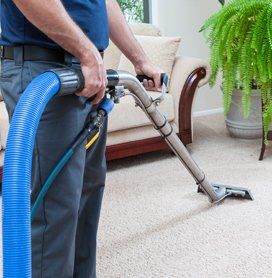Professional Carpet Cleaning and Your Allergies
- By jhendricks@smith-mathis.com (Admin)
- •
- 27 Dec, 2017

A stuffy nose, sneezing, coughing, skin irritations, and difficulty breathing are all common allergy symptoms. If these sound familiar, you aren't alone. Nearly 50 million people in the U.S. suffer from allergies, according to the Asthma and Allergy Foundation of America (AAFA).
Whether its dust mites, pollen, mold spores, or pet dander that are irritating your respiratory system and causing you discomfort, you have plenty of options when it comes to treating your allergies. Along with the medical treatment that your doctor recommends, changing your indoor environment can help alleviate some of your symptoms - like keeping your carpets clean.
If you're not sure what your carpets have to do with your stuffy nose and sneezing, then take a look at how your home's flooring can help or hurt the severity of your allergies.
Understand Triggers
One of the easiest ways to alleviate an allergy is to remove whatever is triggering it. The cause, known as a trigger, must remain present to continue the allergic reaction. If you clean the trigger away, then you're also clearing away the symptoms that you feel.
There are a variety of allergy triggers. The specific triggers you react to depend on your body and your allergy. Common triggers of nasal allergies include dust mites, mold, pollen, and pet dander. Keep in mind that food allergies have different triggers. Obviously, you need to eat or touch the food trigger to have a reaction.
If you're not sure which triggers are causing your allergic reactions, then you need to seek medical attention. The allergist can work with you to determine what you are actually allergic to.
This includes a physical exam, a thorough health history, and possibly a scratch test. During a scratch test, the doctor will prick or puncture your skin with a needle that has the suspected allergen on it. If you have a skin reaction, then you have an allergy.
Reduce Risks
How can you reduce the severity of your symptoms or make your allergy go away? Removing the trigger completely is one way to stop your allergy, but that isn't always possible. You can't cut down every tree or flower outside, and you may not want to get rid of your beloved family pet. If completely removing the trigger is out of the question, then you can reduce its impact through proper household cleaning.
Along with dusting your solid surfaces, cleaning your carpets and upholstery is essential. While vacuuming your carpets can get some of the pet dander, dust mites, and mold spores out of your home, it won't completely clean the trigger away.
This is where professional carpet cleaning comes in. A deep clean can dramatically reduce the amount of the allergen present - helping to greatly reduce your nasal and respiratory symptoms.
Hire a Professional
Why hire a pro to clean your carpets? Even though vacuuming or renting commercially-available carpet cleaners may be inexpensive, they also may not get your carpets as clean as you need them to be. For people without allergies, a simple vacuum cleaning may be enough to make carpets look their best. However, you have a special situation, and that requires added help.
A professional carpet cleaner has the knowledge, equipment, and products to truly reduce allergens. Beyond that, you won't need to worry about having a major reaction during the cleaning process. Cleaning your carpets can kick up the allergens that are affecting you. By having someone else do the work, you reduce the chance that you will come into direct contact with the trigger that's bothering you.
Do you need anti-allergen carpet cleaning? Contact us at Smith-Mathis Inc. for more information on our carpet cleaning services.






